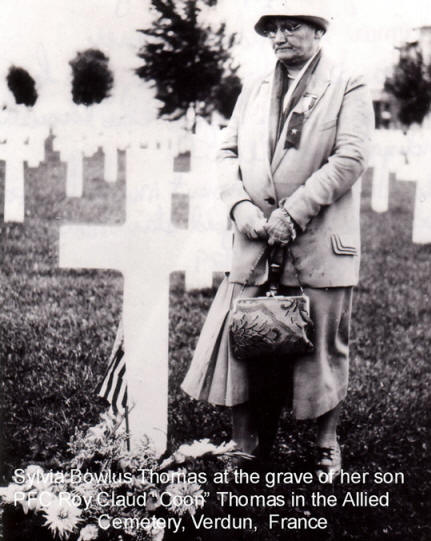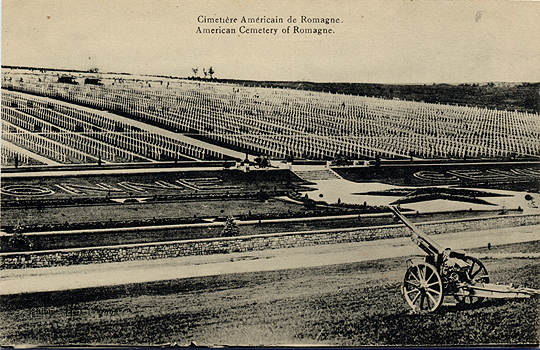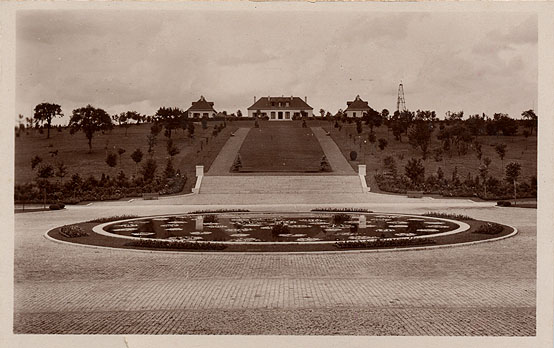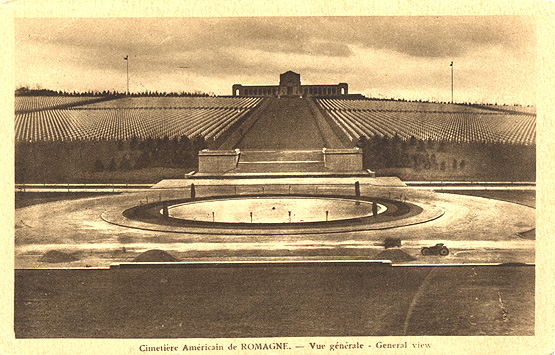|
||||
|
|
||||
 |
||||
|
The cemetery
is located just outside the little village of
Romagne-sous-Montfaucon which was very badly damaged during the
fighting when Leo was killed not far from here. |
||||
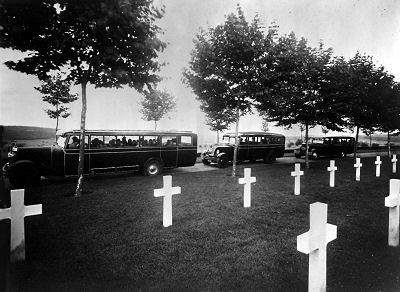 Courtesy of the National Archives |
||||

|
||||
|
||||
|
Development of the Cemetery 1919 - 1936 |
||||
|
||||
|
||||
|
||||
|
||||
|
||||
|
||||
|
||||
|
||||
|
||||
|
Apremont, France |
||||
|
Leo Francis Kelly United States Army
Private First Class Leo Francis Kelly, United States Army died on September 29, 1918 near the village of Apremont, France as a result of combat related injuries resulting from a high explosive artillery shell.
The Meuse Argonne battle for the 35th Division commenced on the morning of the 26th of September just South of Verennes, France and struggled in a Northerly direction toward Exermont. On the morning of the 29th the division was near a small woods called Montrebeau Woods, approximately half way between Baulny and Exermont. It was cold, with a fine rain in the air – at 6:30AM the Germans counterattacked. It is surmised PFC Kelly was killed in action at this time.
At the time of his death the Kansas and Missouri National Guardsmen of the 35th Division were suffering severe internal command problems. On the eve of battle, General Pershing had relieved the two brigade commanders, the chief of staff and three of the four regimental commanders, replacing them with regular Army personnel. They barely had time to introduce themselves before they started fighting the elite Prussian Guards Division.
On September 27 and 28, the 35th Division literally fell apart. The two brigades became chaotically entangled; communications between front and rear virtually ceased. The 35th’s commander, Major General Peter Traub, roved the battlefield in a sleepless daze, out of touch with his own headquarters. At one point he was almost captured by the Germans.
On the 29th, the Prussian Guards launched
a counterattack that caused a near rout. The diary of the German
Third Army reported “concentrated artillery fire struck enemy masses
streaming to the rear with annihilating effect.” The oncoming
German infantry were stopped by counter fire from the 35th’s
field artillery, among which Battery D of the 129th
Regiment, headed by Captain Harry S Truman, performed with
distinction. But on the following day, the shattered division was
withdrawn and replaced by the 1st and 32nd Divisions. When
the Division returned home it had sustained 7,913 casualties during
the time it had been in
France, with the majority occurring during the Meuse-Argonne
Campaign. There were 1,530 deaths, 6,216 wounded and 167 captured
as prisoners of war. By the afternoon of the 29th, gloom and confusion had spread across the entire American battle line. West of the Argonne Forest, the French Fourth Army had barely gained a foot, a mistake making life even more difficult for the Americans in the woods.
PFC Kelly’s remains were recovered and were buried on October 6, 1918 in a combat cemetery on Chaudron Farm, located approximately 2 kilometers (1.2 miles) East of Apremont and not too distant from where he was killed.
After his parents declined to have his remains repatriated to the United States, he was disinterred from Chaudron Farm on February 14, 1922 and transferred to the Meuse-Argonne American Cemetery near Romagne-sous-Montfaucon, France. He was buried in Section 20, Plot 3, Grave # 136. Today his location is given as Plot B, Row 22, Grave # 15.
|
||||
|
|
||||
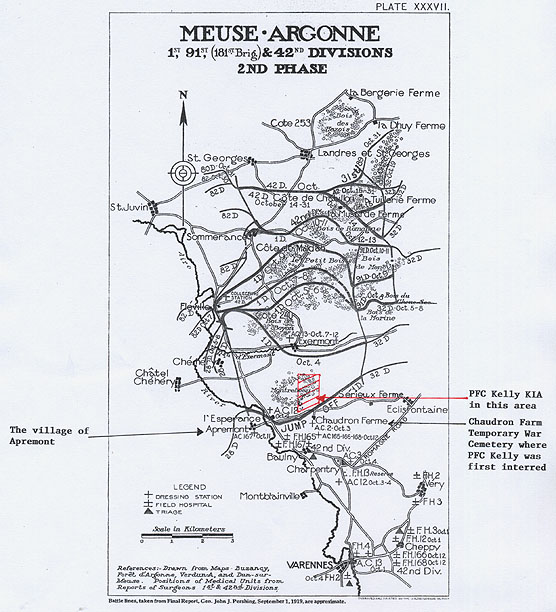 Meuse-Argonne 1st, 91st (181st Brigade) and 42nd Divisions 2nd Phase  Chaudron Farm and Montrebeau Woods From Vauquois Hill to Exermont: A History of the 35th Division by Clair Kenamore |
||||
|
September 26 - November 11, 1918
At the end of August 1918 Marshall Foch had submitted plans to the national commanders for a final offensive along the entire Western Front, with the objective of driving the enemy out of France before winter and ending the war in the spring of 1919. The basis for his optimism was the success of Allied attacks all along the front in August. Furthermore, he pointed out, the Allies already had active operations in progress between the Moselle and Meuse, the Oise and Aisne, and on the Somme and Lys Rivers. Foch acknowledged that the Germans could stave off immediate defeat by an orderly evacuation combined with destruction of material and communications. Therefore the overall aim of the fall offensive would be to prevent a step-by-step enemy retirement. As Foch anticipated, the Germans eventually contributed to the success of his strategy. Their High Command could not bring itself to sacrifice the huge stores collected behind front lines, and so delayed the withdrawal of its armies.
Foch’s great offensive, planned to begin in the last week of September, called for a gigantic pincers movement with the objective of capturing Aulnoye and Mezieres, the two key junctions in the lateral rail system behind the German front. Lose of either of these junctions would seriously hamper the German withdrawal. Despite grumbling from the English that they lacked the necessary manpower, a chiefly British army was assigned the task of driving toward Aulnoye. The A.E.F. was designated for the southern arm of the pincers, the thrust on Mezieres. Simultaneously the Belgian-French-British army group in Flanders would drive toward Ghent, and the French armies in the Oise-Aisne region would exert pressure all along their front to lend support to the pincers attack.
General Pershing decided to strike his heaviest blow in a zone about 20 miles wide between the Heights of the Meuse on the east and western edge of the high, rough, and densely wooded Argonne Forest. This is difficult terrain, broken by a central north-south ridge that dominates the valleys of the Meuse and Aire Rivers. Three heavily fortified places - Montfaucon, Cunel and Barricourt - as well as numerous strong points barred the way to penetration of the elaborate German defenses in depth that extended behind the entire front. This fortified system consisted of three main defense lines backed up by a fourth line less well-constructed. Pershing hoped to launch an attack with enough momentum to drive through these lines into the open area beyond, where his troops could then strike at the exposed German flanks and, in a coordinated drive with the French Fourth Army coming up on the left, could cut the Sedan-Mezieres railroad.
On the 20 mile Meuse-Argonne front where the main American attack was to be made, Pershing disposed three corps side by side, each with three divisions in line and one in Corps reserve. In the center was the V Corps (from right to left the 79th, 37th, and 91st Divisions with the 32nd in reserve), which would strike the decisive blow. On the right was the III Corps (from right to left the 33rd, 80th and 4th Divisions with the 3rd in reserve), which would move up the west side of the Meuse. On the left was I Corps (from right to left the 35th, 28th and 77th Divisions with the 92nd in reserve), which would advance parallel to the French Fourth Army on its left. Eastward across the Meuse the American front extended in direct line some 60 miles; this sector was held by two French Corps (IV and II Colonial) and the American IV Corps in the St. Mihiel sector. Pershing had available to support his offensive nearly 4000 guns, two-thirds manned by American artillerymen; 190 light French tanks, mostly with American personnel; and some 820 aircraft, 600 of them flown by Americans.
|
||||
|
Exermont, France The Great American Cemetery in the Argonne Identify All But 4 Per Cent of Dead: America's Heroes to Rest in Fields of Honor in France *Photos of PFC Roy Claud Thomas
and Sylvia Thomas courtesy of
|
||||
| Continue the Journey | ||||

